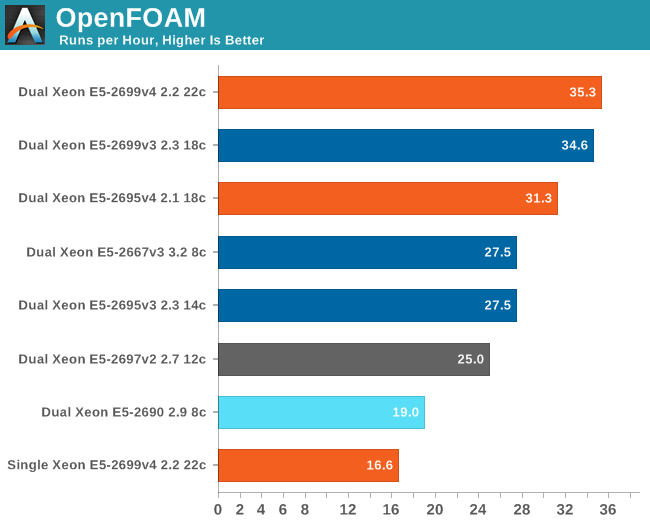The Intel Xeon E5 v4 Review: Testing Broadwell-EP With Demanding Server Workloads
by Johan De Gelas on March 31, 2016 12:30 PM EST- Posted in
- CPUs
- Intel
- Xeon
- Enterprise
- Enterprise CPUs
- Broadwell
HPC: Fluid Dynamics with OpenFOAM
Computational Fluid Dynamics is a very important part of the HPC world. Several readers told us that we should look into OpenFOAM, and my lab was able to work with the professionals of Actiflow. Actiflow specializes in combining aerodynamics and product design. Calculating aerodynamics involves the use of CFD software, and Actiflow uses OpenFOAM to accomplish this. To give you an idea what these skilled engineers can do, they worked with Ferrari to improve the underbody airflow of the Ferrari 599 and increase its downforce.
We were allowed to use one of their test cases as a benchmark, however we are not allowed to discuss the specific solver. All tests were done on OpenFOAM 2.2.1 and openmpi-1.6.3. The reason why we still run with OpenFOAM 2.2.1 is that our current test case does not work well with higher versions.
We also found AVX code inside OpenFoam 2.2.1, so we assume that this is one of the cases where AVX improves FP performance.

As this is AVX code, the clock speed of our Xeon processors can be lower than Intel's official specifications, and turbo boost speeds are also lower. Despite the fact that on Broadwell the only cores that reduce their clock when running AVX code are the AVX-active cores themseves (the others can continue at higher speeds), OpenFOAM does not run appreciably faster on the top of the line Xeon E5 v4 than it did on the E5 v3.
It is not as if OpenFOAM does not scale: 22% more cores delivers 13% higher performance (E5-2699v4 vs E5-2695v4). No, our first impression is that the new Xeon v4 needs to lower the clockspeed more than the old one. The official specifications tell us that both the Xeon E5-2699 v4 and v3 should run AVX code at up to 2.6 GHz with all cores enabled. The reality is however that Broadwell runs at a lower clock on average.










112 Comments
View All Comments
jhh - Thursday, March 31, 2016 - link
The article says TSX-NI is supported on the E5, but if one looks at Intel ARK, it say it's not. Do the processors say they support TSX-NI? Or is this another one of the things which will be left for the E7?JohanAnandtech - Friday, April 1, 2016 - link
Intel's official slides say: "supports TSX". All SKUs, no exceptions.Oxford Guy - Thursday, March 31, 2016 - link
Bigger, badder, still obsolete cores.patrickjp93 - Friday, April 1, 2016 - link
Obsolete? Troll.Oxford Guy - Tuesday, April 5, 2016 - link
Unlike you, propagandist, I know what Skylake is.benzosaurus - Thursday, March 31, 2016 - link
"You can replace a dual Xeon 5680 with one Xeon E5-2699 v4 and almost double your performance while halving the CPU power consumption."I mean you can, but you can buy 4 X5680s for a quarter the price of a single E5-2699v4. It takes a lot of power savings to make that worthwhile. The pricing in the server market's always seemed weirdly non-linear to me.
warreo - Friday, April 1, 2016 - link
Presumably, it's not just about TCO. Space is at a premium in a datacenter, and so being able to fit more performance per sq ft also warrants a higher price, just like how notebook parts have historically been more expensive than their desktop equivalents.ShieTar - Friday, April 1, 2016 - link
But you don't get 4 1366-Systems for the price of one 2011-3 System. Depending on your Memory, Storage and Interconnect Needs, even two full Systems based on the Xeon 5680 may cost you more than one system based on the E5-2699 v4. One less Infiniband-Adapter can easily save you 500$ in Hardware.And you are not only halving the CPU power consumption, but also the power consumption of the rest of the system that you no longer use, so instead of 140W you are saving probably at least 200W per System, which can already add up to more than 1k$ in electricity and cooling bills for a 24/7 machine running for 3 years.
And last, but by no means least, less parts means less space, less chance for failure, less maintenance effort. If you happily waste a few hours here or there to maintain your own workstation, you don't do the math, but if you have to pay somebody to do it, salaries matter quickly. With an MTBF for an entire server rarely being much higher than 40.000, and recovery/repair easily taking you a person-day of work, each system generates about 1.7 hours of work per year. Cost of work (it's more than salaries, of course) probably comes up to 100$ for a skilled technical administrator, thus producing another 500$ over 3 years of added operational cost.
And of course, space matters as well. If your data center is filled, it can be more cost effective to replace the old CPUs with new expensive ones, rather than build a new facility to fill with more old Systems.
If you add it all up, I doubt you can get a System with an Xeon 5680 and operate it over 3 years for anything below 20.000$. So going from two 20.000$-Systems to a single 24.000$ Dollar System (because of an extra 4000$ for the big CPU) should save you a lot of money in the long run.
JohanAnandtech - Friday, April 1, 2016 - link
Where do you get your pricing info from? I can not imagine that server vendors still sell X5680s.extide - Friday, April 1, 2016 - link
Yeah, if you go used. No enterprise sysadmin worth his salt is ever going to put used gear that is not in warranty, and in support into production.